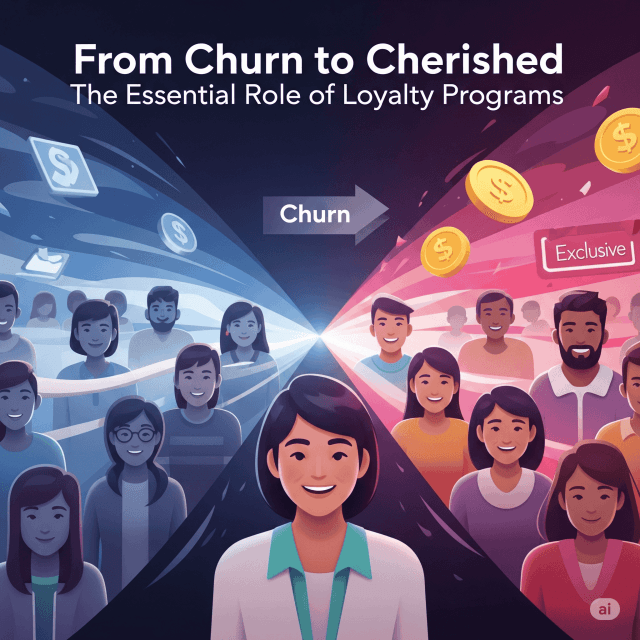In today’s hyper-competitive marketplace, businesses face an uphill battle in retaining customers. With multiple options available at consumers’ fingertips, customer churn—the rate at which customers stop doing business with a company—can significantly impact bottom lines. Enter loyalty programs: strategic initiatives designed to convert occasional buyers into loyal patrons.
Understanding Customer Churn
Customer churn is more than just a statistical inconvenience; it represents lost revenue potential and diminished brand value. According to research, acquiring a new customer can cost five to twenty-five times more than retaining an existing one. This stark reality emphasizes the necessity for businesses to not only understand why customers leave but also to actively address those concerns. This is where loyalty programs come into play.
The Mechanics of Loyalty Programs
Loyalty programs come in various shapes and sizes, from simple punch cards to sophisticated digital rewards systems. At their core, these programs are designed to incentivize repeat purchases by offering rewards for continued patronage. Common structures include:
Points-Based Systems: Customers earn points for each purchase, redeemable for discounts, products, or exclusive experiences.
Tiered Rewards: Customers unlock different rewards based on their spending, encouraging them to reach higher tiers for better benefits.
Subscription-Based Programs: Customers pay a fee for exclusive benefits, such as free shipping or members-only discounts, effectively creating a sense of belonging.
- Partnership Programs: Collaborations with other businesses to provide customers with rewards across a spectrum of products and services.
The Benefits of Loyalty Programs
1. Enhanced Customer Retention
Loyalty programs create an emotional bond between the brand and the consumer. When customers feel rewarded for their loyalty, they are less likely to switch to competitors.
2. Increased Customer Lifetime Value (CLV)
By encouraging repeat purchases and fostering a sense of belonging, loyalty programs can significantly increase the average CLV. Long-term customers tend to spend more over time, making them invaluable to businesses.
3. Valuable Customer Insights
Loyalty programs allow businesses to gather data about consumer preferences, behaviors, and purchasing patterns. This data can inform targeted marketing campaigns, product offerings, and customer service enhancements.
4. Brand Advocacy
Happy, loyal customers are your best ambassadors. They are more likely to refer friends and family, share positive experiences on social media, and leave favorable reviews.
5. Differentiation in a Crowded Market
In sectors with thin profit margins and stiff competition, loyalty programs can serve as a significant differentiator. Offering unique benefits sets a brand apart from the rest and adds perceived value.
Crafting an Effective Loyalty Program
To maximize the effectiveness of a loyalty program, businesses should consider the following:
1. Understand Your Customer Base
Conduct surveys and analyze data to comprehend what drives customer loyalty in your specific market. Tailor the program accordingly.
2. Keep it Simple
Complex programs may confuse customers. Ensure that the sign-up process, how to earn points, and the redemption process are straightforward.
3. Offer Genuine Value
Rewards should be appealing and attainable. This could mean a mix of immediate rewards for small purchases and bigger rewards for larger transactions.
4. Communicate Regularly
Engage with loyalty program members through newsletters, app notifications, or social media. Keep them informed about new rewards, exclusive offers, and program updates.
5. Continuously Evaluate and Adapt
Regularly assess the program’s performance. Collect feedback, analyze engagement rates, and make adjustments to keep the program fresh and valuable.
Challenges to Consider
While loyalty programs can be highly lucrative, they are not without challenges. Managing costs, ensuring a seamless customer experience, and preventing fraud all require strategic planning and ongoing management. Additionally, as consumer preferences evolve, loyalty programs must adapt to remain relevant.
Conclusion
From churn to cherished, loyalty programs have emerged as vital tools for modern businesses aiming to sustain customer relationships and enhance brand loyalty. By understanding the nuances of customer behavior and delivering meaningful rewards, brands can transform transient buyers into devoted advocates. In the ever-changing landscape of consumerism, the right loyalty program can turn the tide, ensuring customers stay not just for a transaction but for a lasting relationship.









